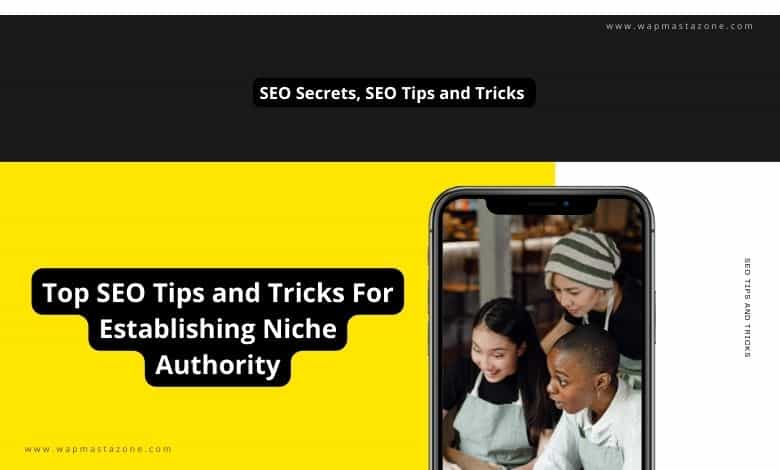Top 14 SEO Tips and Tricks For Establishing Niche Authority
SEO Tips and Tricks, seo secrets, seo success

How can you establish authority on Google through SEO tips and tricks? establishing a niche authority on Google requires great effort, originality, and consistency. Since ranking as a niche authority on Google helps to attract a dedicated audience and traffic, it is then important for you to invest in these 14 SEO secrets and SEO tips and tricks.
Top 14 SEO Tips and Tricks for Establishing Authority on Google
1. Thorough Keyword Research:
Thorough keyword research involves identifying and selecting the most relevant and valuable keywords for your content. Start by understanding your target audience and their search intent. Utilize keyword research tools to uncover high-traffic, low-competition keywords to target in your content. Brainstorm a list of potential keywords, considering both broad and specific terms. Use keyword research tools to analyze search volume, competition, and trends. Prioritize keywords with high search volume and low competition that align with your content’s purpose. Keep an eye on long-tail keywords for niche targeting. Regularly update and refine your keyword list based on changing trends and user behavior. Effective keyword research enhances your content’s discoverability and relevance in search engine results.
Also read: Top 15 Free Keyword Research Tools
Also read: Differences And Benefits of Short and Long Tail Keywords in SEO
2. Create High-Quality Content
Content remains king, and Google rewards websites that deliver valuable, well-researched, and authoritative content. Focus on producing in-depth articles, guides, and resources that address your audience’s pain points and provide solutions.
Crafting high-quality content is an art and strategy that requires understanding your audience, clear structure, a compelling headline and introduction, valuable and relevant content based on solid research, clear and concise language, an engaging tone that matches your purpose, incorporating visual elements for enhanced readability, formatting with subheadings and short paragraphs, maintaining originality and giving credit when necessary, integrating storytelling for relatability, thorough proofreading, and editing, optimizing for SEO by including relevant keywords naturally, seeking feedback for continuous improvement. Following these steps will help you create content that effectively engages and resonates with your target audience.
Also read: Google Indexing and How Web Crawler Works
Also read: 13 Key Indications that your SEO Strategy is Successful
3. Optimize On-Page SEO Elements:
Optimizing on-page SEO is one of the SEO tips and tricks you can adopt. It involves enhancing various aspects of your webpage to improve its search engine visibility. Craft a concise and descriptive title tag that includes your target keyword. Write a compelling meta description that entices users to click. Incorporate your primary keyword naturally within the content, maintaining readability. Structure your content with headings (H1, H2, etc.) that offer a hierarchy of information. Utilize descriptive image alt text for accessibility and SEO benefits. Ensure your URL is simple, containing relevant keywords. Aim for a user-friendly, mobile-responsive design. Implement internal linking to connect related content. Lastly, monitor and analyze your on-page performance to make necessary refinements and to enhance the user experience.
Also read: The Concept of ON Page SEO – Ultimate Guide
Also read: The Concept of OFF Page SEO – Ultimate Guide
4. Invest in User Experience (UX):
Google prioritizes websites that provide a positive user experience and it is another SEO tips and tricks you should leverage. Optimize site speed, mobile responsiveness, and site navigation to ensure visitors can easily find and consume your content.
Ensure to create a website or application that prioritizes user satisfaction and ease of use. First, understand your target audience’s needs and how to interact and behave on your website. Design an intuitive and user-friendly interface, focusing on clear navigation and organized content. Ensure fast loading times to prevent user frustration. Create responsive designs that adapt to different devices and screen sizes. Incorporate visually appealing elements that enhance engagement. Implement logical information architecture for easy content discovery. Streamline forms and interactions to minimize friction. Test your UX design through user feedback and usability testing, making iterative improvements based on real-world usage.
Suggested read: UX and SEO – The Impact of UX on SEO
5. Earn High-Quality Backlinks:
A backlink is a link from one website to another web resource. The web resource can be a website, web page, images, or resource content on another website.
Websites can link to one another essential for the resourceful content they provide or to vouch for the quality and credibility of the website. If these backlinks are coming from high-authority websites, this will inform search engines about the quality of the content. Search engine rewards this by indexing and ranking the website’s pages higher.
So, build a strong backlink profile by acquiring links from authoritative and relevant websites in your niche. Google considers backlinks as a vote of confidence, signaling that your content is trustworthy and valuable.
Also read: Backlinks in SEO – How to Acquire High Authority Backlinks
6. Leverage Long-Form Content:
Incorporate long-form content into your SEO strategy, as longer articles tend to perform better in search results. Aim for articles from 900 words and above, offering comprehensive information to your audience.
7. Embrace Video Content:
Diversify your content by incorporating video content. Video engages users, encourages longer on-page time, and can enhance your niche authority on Google.
8. Harness Social Media Platforms:
Another important SEO tips and tricks you can leverage is the power of social media to promote your content and engage with your audience. Being active on social media presence can help you build a loyal following and expand your reach.
Optimize your social media profiles with relevant keywords and a consistent brand presence. Engage with your audience by responding to comments, messages, and fostering discussions. Share your website’s content on social media to increase its exposure and potentially earn backlinks. Collaborate with influencers or other brands to expand your reach. Use hashtags strategically to increase discoverability.
Also read: 7 Proven Steps To Grow Your Domain Authority
Also read: 7 Most Common SEO Mistakes you Should Avoid
9. Local SEO for Niche Businesses:
If your niche targets a local audience, optimize your website for local SEO. Claim and optimize your Google My Business listing with accurate and up-to-date information. Choose relevant categories and add high-quality photos that showcase your niche offerings. Encourage customers to leave reviews, as positive reviews can enhance your local reputation. Develop location-specific content on your website that highlights your niche expertise and local relevance. Ensure your website is mobile-friendly and responsive, as many local searches happen on mobile devices. Consistently update your business details across online directories to maintain accuracy.
10. Engage with Your Audience:
Encourage user comments, respond to feedback, and engage with your audience. Building a community around your niche fosters loyalty and strengthens your authority.
11. Utilize Data and Analytics:
There are many data analysis software or applications you can you to track and analyze how users interact with your website. E.g., Spysuggest, Google webmaster tool, seo optimizer, Google Analytics, Bing webmaster, etc. So, ensure to analyze data and website analytics regularly to track progress, identify strengths and weaknesses, and make data-driven decisions for optimizing your SEO efforts.
Also read: How to Find a Domain Name
Also read: 6 Reasons Why you Should buy a Custom Domain
12. Collaborate and Network:
Ensure to collaborate with other niche authorities, participate in webinars, guest posts on relevant blogs, and engage in partnerships to extend your reach and tap into new audiences.
13. Optimize for Voice Search:
The current state of voice search is that it is still a relatively new technology, but it is growing rapidly. According to a study by eMarketer, there were 111.8 million voice assistant users in the US in 2019, which is up 9.5% from the previous year. This number is expected to continue to grow in the coming years, with some experts predicting that half of all searches will be voice searches by 2025. One of the reasons for the growth of voice search is the increasing popularity of smart speakers.
With the rise of voice-enabled devices, optimizing your content for voice search queries hence become important. Create content that answers common voice search questions to capture voice traffic.
Suggested read: The Future of Voice Search and its Implications For SEO
14. Implement Structured Data Markup:
Utilize structured data markup (Schema.org) to help search engines understand your content better. This can enhance your chances of getting rich snippets in search results.
Recommended: Schema Markup Generator 1
Recommended: Schema Markup Generator 2



